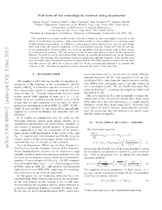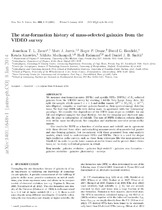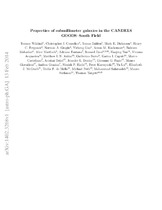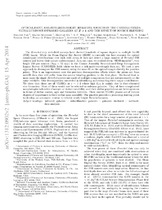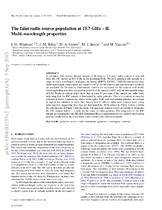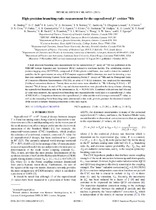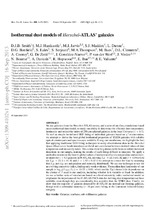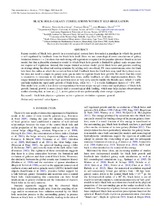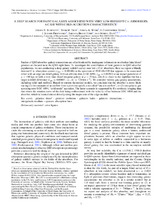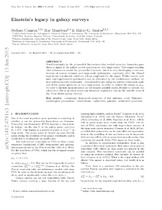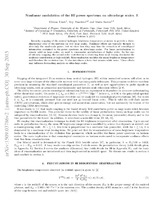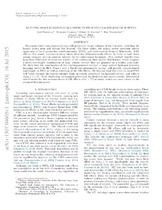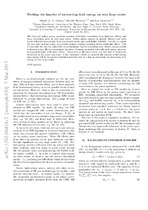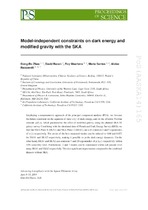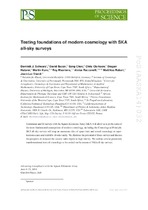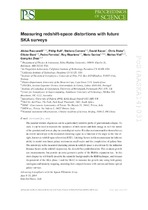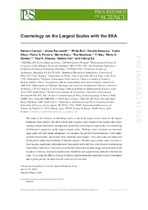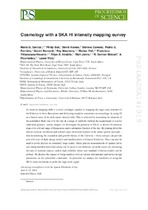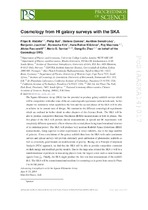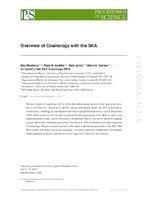Physics and Astronomy: Recent submissions
Now showing items 501-520 of 520
-
Null tests of the cosmological constant using supernovae
(American Physical Society, 2014)The standard concordance model of the Universe is based on the cosmological constant as the driver of accelerating expansion. This concordance model is being subjected to a growing range of inter-locking observations. ... -
The star-formation history of mass-selected galaxies from the VIDEO survey
(Oxford University Press, 2014)We measure star formation rates (SFRs) and specific SFRs (SSFRs) of Ks-selected galaxies from the VISTA Deep Extragalactic Observations survey by stacking 1.4 GHz Very Large Array data. We split the sample, which spans 0 ... -
Properties of submillimeter galaxies in the CANDELS GOODS-south field
(American Physical Society, 2014)We derive physical properties of 10 submillimeter galaxies located in the CANDELS coverage of the GOODS-S field. The galaxies were first identified as submillimeter sources with the LABOCA bolometer and subsequently targeted ... -
Optical-faint, far-infrared-bright Herschel sources in the CANDELS fields: Ultra-luminous infrared galaxies at z > 1 and the effect of source blending
(American Astronomical Society, 2014)The Herschel very wide-field surveys have charted hundreds of square degrees in multiple far-IR (FIR) bands. While the Sloan Digital Sky Survey (SDSS) is currently the best resource for optical counterpart identifications ... -
The faint radio source population at 15.7 GHz - II. Multi-wavelength properties
(Oxford University Press, 2015)A complete, flux density limited sample of 96 faint (> 0:5 mJy) radio sources is selected from the 10C survey at 15.7 GHz in the Lockman Hole. We have matched this sample to a range of multi-wavelength catalogues, including ... -
High-Precision Branching Ratio Measurement for the Superallowed + Emitter 74Rb
(American Physical Society, 2013)A high-precision branching-ratio measurement for the superallowed β + decay of 74Rb was performed at the TRIUMF Isotope Separator and Accelerator (ISAC) radioactive ion-beam facility. The scintillating electronpositron tagging ... -
Isothermal dust models of Herschel-ATLAS galaxies
(Oxford University Press, 2013)We use galaxies from the Herschel-ATLAS survey, and a suite of ancillary simulations based on an isothermal dust model, to study our ability to determine the effective dust temperature, luminosity and emissivity index of ... -
Black hole - galaxy correlations without self-regulation
(American Astronomical Society, 2013)Recent models of black hole growth in a cosmological context have forwarded a paradigm in which the growth is self-regulated by feedback from the black hole itself. Here we use cosmological zoom simulations of galaxy formation ... -
A deep search for faint galaxies associated with very low-redshift C iv absorbers: A case with cold-accretion characteristics
(The American Astronomical Society, 2013)Studies of QSO absorber–galaxy connections are often hindered by inadequate information on whether faint/dwarf galaxies are located near the QSO sight lines. To investigate the contribution of faint galaxies to QSO ... -
Einstein's legacy in galaxy surveys
(Oxford University Press, 2015)Non-Gaussianity in the primordial fluctuations that seeded structure formation produces a signal in the galaxy power spectrum on very large scales. This signal contains vital information about the primordial Universe, but ... -
Nonlinear modulation of the HI power spectrum on ultra-large scales. I
(IOP Science, 2015)Intensity mapping of the neutral hydrogen brightness temperature promises to provide a three-dimensional view of the universe on very large scales. Nonlinear effects are typically thought to alter only the small-scale ... -
Hunting down horizon-scale effects with multi-wavelength surveys
(American Astronomical Society, 2015)Next-generation cosmological surveys will probe ever larger volumes of the universe, including the largest scales, near and beyond the horizon. On these scales, the galaxy power spectrum carries signatures of local primordial ... -
Probing the imprint of interacting dark energy on very large scales
(American Physical Society, 2015)The observed galaxy power spectrum acquires relativistic corrections from light-cone effects, and these corrections grow on very large scales. Future galaxy surveys in optical, infrared and radio bands will probe increasingly ... -
Model-independent constraints on dark energy and modified gravity with the SKA
(Proceedings of Science, 2014)Employing a nonparametric approach of the principal component analysis (PCA), we forecast the future constraint on the equation of state w(z) of dark energy, and on the effective Newton constant m(k; z), which parameterise ... -
Testing foundations of modern cosmology with SKA all-sky surveys
(Proceedings of Science, 2014)Continuum and HI surveys with the Square Kilometre Array (SKA) will allow us to probe some of the most fundamental assumptions of modern cosmology, including the Cosmological Principle. SKA all-sky surveys will map an ... -
Measuring redshift-space distortion with future SKA surveys
(Proceedings of Science, 2014)The peculiar motion of galaxies can be a particularly sensitive probe of gravitational collapse. As such, it can be used to measure the dynamics of dark matter and dark energy as well the nature of the gravitational laws ... -
Cosmology on the largest scales with the SKA
(Proceedings of Science, 2014)The study of the Universe on ultra-large scales is one of the major science cases for the Square Kilometre Array (SKA). The SKA will be able to probe a vast volume of the cosmos, thus representing a unique instrument, ... -
Cosmology with a SKA HI intensity mapping survey
(Proceedings of Science, 2014)HI intensity mapping (IM) is a novel technique capable of mapping the large-scale structure of the Universe in three dimensions and delivering exquisite constraints on cosmology, by using HI as a biased tracer of the ... -
Cosmology from HI galaxy surveys with the SKA
(Proceedings of Science, 2014)The Square Kilometer Array (SKA) has the potential to produce galaxy redshift surveys which will be competitive with other state of the art cosmological experiments in the next decade. In this chapter we summarise what ... -
Overview of Cosmology with the SKA
(Proceedings of Science, 2014)The new frontier of cosmology will be led by three-dimensional surveys of the large-scale structure of the Universe. Based on its all-sky surveys and redshift depth, the SKA is destined to revolutionize cosmology, in ...

